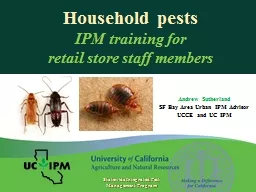

Household pests IPM training for retail store staff members Statewide Integrated Pest Management Program Andrew Sutherland SF Bay Area Urban IPM Advisor UCCE and UC IPM Training outline Basic biology ecology and general management of common pests review of UC IPM materials ID: 765784
Download Presentation The PPT/PDF document "Household pests IPM training for" is the property of its rightful owner. Permission is granted to download and print the materials on this web site for personal, non-commercial use only, and to display it on your personal computer provided you do not modify the materials and that you retain all copyright notices contained in the materials. By downloading content from our website, you accept the terms of this agreement.
Household pests IPM training for retail store staff members Statewide Integrated Pest Management Program Andrew SutherlandSF Bay Area Urban IPM AdvisorUCCE and UC IPM
Training outline Basic biology, ecology, and general management of common pests; review of UC IPM materialsWood-destroying insects (termites)AntsBed bugsCockroachesPantry pests
TermitesSubterranean: Reticulitermes (and others)Most common and smallest termite in urban CANests in soil (except for carton nests)Drywood: IncisitermesCommon in parts of CANests in wood (difficult to detect)Dampwood: ZootermopsisLargest and least common pest termiteNests in buried or wet wood
Is it an ant or a termite? Antennae: elbowed vs. string-of-beadsConstriction in abdomen (‘waist’)?Wings: different sizes or all same size?Wing veins: reduced or many (net-like)?
Subterranean termite signs
Drywood termite signs
Drywood termite damage Consume wood along and across grain
TermitesMessages for your customer: Retail pesticide products labeled for termites are ‘contact only’Only kill accessible termites directly in contact with spray or residueWill not impact whole coloniesException: bait stations for subterranean termites‘Contact a pest management professional’‘Consider prevention and exclusion’
Termite bait products for DIY homeownersTerminate (1997; Spectrum)Original a.i.: sulfuramid (stomach poison)Now (Dow / Spectracide): hexaflumuron (IGR: CSI) Termirid (1998, inactive)Sodium borateEffective? New Terminate same as 1st gen. Sentricon / Recruit II: 0.5% hexaflumuron (professional-use product)
Minor wood-destroying pests Carpenter bee:Large diameter (1/2”), tubular holes.Prefer softer woods.Prevention is best management tactic.Carpenter ant:Large ants, conspicuous trails, copious frass. Exclusion and baits.
Education Identification is paramount!Outdoor or indoor resident?IPM for ants
Ants outsideImportant predators, scavengers But…‘farm’ honeydew-excreting garden pestsInterfere with natural enemies
Why do ants invade?Water, shelter, moderate temperatures Uncontained/unsealed food resources
IPM for ant invasions: exclusion is key
Ant bait stationsMust contain slow-acting toxin 1% borate best for ArgentineProtein-based baits during brood
AntsMessages for your customers: Exclude ants from invading by properly sealing structuresWipe up ants and their trails indoorsUse baits and bait stationsAllow up to two weeks for complete controlSprays will not keep ants out of your homeOutdoor spray residues can contaminate surface water
Bed bugs: Heteroptera: Cimicidae
Bed bug biologyLife cycle: egg, 5 nymphal instars, adultsAll obligate blood feedersNest parasites (harborages within ~6’ from host)NOT KNOWN to vector human pathogens
Identify the problemDo you have bed bugs? Impossible to know based on dermal symptoms aloneNo such thing as a ‘typical bed bug bite’Confirmation requires signs and / or specimen
Consider tenants’ rightsMessages for your customer: Report infestation to landlord / management ASAPCooperate with all management effortsGet help if necessary: tenants’ rights groups
Nonchemical tactics Disposal of infested items (clearly marked)Clutter managementBarriers (encasements, interceptors)Laundering (heat is most important)Vacuum (provide HEPA filter)SteamHeat (> 45oC or > 115o F, 2 – 4 hours min.)Cold (below freezing, at least five days)
Chemical control of bed bugs Retail products unlikely to completely control infestationsMostly ‘contact only’ materialsDesiccants can help, if applied correctlyNo proven ‘repellents’ available‘bug bombs’ can be dangerous!Most of the effective materials are only available to pest management professionals
Bed bugs Messages for your DIY customersIdentify the problemConsider tenants’ rightsUse nonchemical tacticsConsider insecticides carefullyDesiccants can work: don’t over-apply themVirtually all retail products are ‘contact only’
IPM for cockroachesIndoor resident or outdoor invader? German cockroach, adults: ½ inchOriental cockroach, adults: 1 ¼ inch
IPM for cockroachesIndoor resident spp. Sanitation, food containment, moisture managementGel baitsOutdoor invader spp.Exclusion: door sweeps!Landscape / habitat / moisture managementTolerance?Granular baits? Sprays?
CockroachesMessages for your customers: Try to identify species:Small vs. large, indoor vs. outdoorManage indoor species using sanitation measures and baits (gels work best)Exclude outdoor species from entering your home by properly sealing the structureSprays will not keep cockroaches out of your home
Pantry pests
IPM for pantry pestsMessages for your customers: Throw out infested foodClean up cabinets and storage areas with vacuum, soap and waterUse pheromone traps to detect Indian meal moth infestationsStore food in hard containersFreeze bulk purchases for five days or so before placing in storage
Thanks!...Questions?Andrew Sutherland Bay Area Urban IPM Advisoramsutherland@ucanr.eduhttp://ucanr.edu/sites/urbanIPM/510-670-5624 office510-499-2930 cell224 W Winton Avenue, Room 134; Hayward